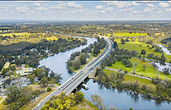Everything you need to know about the super/house concept.
The Prime Minister has used the Liberal Party’s campaign launch to announce a plan to allow first home buyers to use their superannuation to purchase a property.
Key points:
-
Mr Morrison announced the Super Home Buyer scheme at the Coalition’s election campaign launch in Brisbane
-
First home buyers would be able to use up to 40 per cent of their super, up to $50,000, to put towards buying a home
-
Former Liberal prime minister Malcolm Turnbull did not attend the launch
The Liberal Party chose Brisbane to officially launch their campaign, only six days out from election day.
Resource-rich Queensland was key to the Coalition’s “miracle” win at the 2019 election, with Scott Morrison echoing his election-night line at Sunday’s event, opening with: “How good is it to be in Queensland.”
Mr Morrison went on to announce the Super Home Buyer scheme, which — if the Coalition is re-elected on Saturday — would enable first home buyers to use up to 40 per cent of their super, up to $50,000, to put towards buying a home.
The Coalition says this would slash the time needed to save a house deposit by three years on average.
“A re-elected Coalition government will allow first home buyers to invest a responsible portion of their own superannuation savings into their first home,” Mr Morrison said.
“This would apply to both new and existing homes and whatever amount is invested will be returned to your super when you sell the home, including the share of the capital gain from the sale of that home.
“Superannuation is there to help Australians in their retirement — the evidence shows that
“The best thing we can do to help Australians achieve financial security in their retirement is to help them own their own home.”
If the Coalition is re-elected, the scheme would begin on July 1, 2023, for first home buyers who must have saved another five per cent of their deposit separately.
The buyer must also live in the home for at least 12 months, but there are no age, property or income thresholds.
Shadow Housing Minister Jason Clare described the policy as the “last desperate act of a dying government” and that people struggling the most to enter the housing market would not be helped because they typically had the lowest superannuation savings.
He also said it would “add fuel to the fire” of house prices, and drive them up.
Mr Clare pointed to other senior Liberal Party figures including former prime minister Malcolm Turnbull, former finance minister Mathias Cormann and Peter Costello who have been vocally against the idea.
“I think the Australian people can see through this… and know that if this was a good idea the [government] would’ve done it years ago, not six days before the election,” he said.
Todays Good Reads
Sports marketing goes next level
The San Diego Chargers break the internet.
Across the ditch
Sustainable options at home
What you can plant to produce produce for the home.

Super: The elephant in the room for fiscal policy
Australia’s first pension plans were established in 1857 by the Australian Mutual Provident Society (now known as AMP) and in 1885 they set up one of the first staff pension funds in the world.
Since then the super savings pool has grown to almost $3 trillion, being one and a half times the size of Australia’s entire economy. Superannuation is now well on its way to becoming the biggest investment pool Australia will ever see.
Australians are getting older. We are living longer and are having fewer children. The problem is that as we are getting older there will be fewer taxpayers to pay the taxes that will fund our aged pensions. The problem is so extreme that the government forecasts that by mid this century Australia will have almost 40 million people with just three taxpayers supporting each retiree compared to almost five per retiree today.
To help pay for us in our greying years, the government has been trying to encourage us to save for our retirement through superannuation using incentives such as promising to increase compulsory contributions paid by employers from nine to 12% (it is now 9.5%) and giving us tax concessions on our superannuation contributions, investment earnings and end benefit payments.
Making this challenge ever more daunting, Australians retiring in future years will want a higher standard of living and a more sophisticated retirement lifestyle than any previous generation of retirees. The 2008 global financial crisis and increasing levels of government debt just added to these pressures.
Superannuation is also important to just about every employer as nearly a tenth of their payroll goes into superannuation each year. For some generous employers, these super contributions are even higher. Little wonder we all talk about super so much even though we claim to be disinterested in it.
These forces are so strong that the modern superannuation industry that has grown out of these incentives usually doubles every five years or so. It’s even projected by Rainmaker Information to climb to $10 trillion within the next 20 years to become the biggest savings pool Australia has ever seen.
Superannuation has, however, changed tremendously since its early days when private pensions were paid only to senior, long serving permanent staff in large private companies and government departments.
In those days superannuation was predominantly held by white-collar males and most superannuation funds were defined benefit, meaning your retirement benefit was determined by your age, how long you were with the same employer and what your final salary was when you retired.
But all that changed in the 1980s when as part of the National Wage Case, the government supported the ACTU in its claim before the Arbitration Commission for a 3% productivity payment to be paid to all Australian Workers in the form of Award Superannuation. This was the spur that saw superannuation smash down barriers like gender discrimination to include many millions more workers such as women, the low paid and those who weren’t employed by large companies or the public sector.
At last count more than 95% of Australian workers, being about 13 million people now, have superannuation, more than twice the proportion of 20 years ago when only about six million people had superannuation.
This transformation of superannuation is so complete it is a major feature of most industrial awards, especially following the latest review of awards following the government’s Fair Work legislation and Award Modernisation program.
But as far as superannuation has come it remains a work in progress as governments continually reform it and the industry itself strives to become more efficient, more tech-savvy and deliver better investment outcomes for lower fees. This makes superannuation so big and important that it is quite literally the centrepiece of every Australian’s long term financial plan.
Content with more content
Now if you prefer to consume your information through audio instead of through text (which is understandable) come and check out or podcast which lives here. It is a show we are doing weekly which has a nice blend of education and entertainment aimed at the prospective homebuyer.





